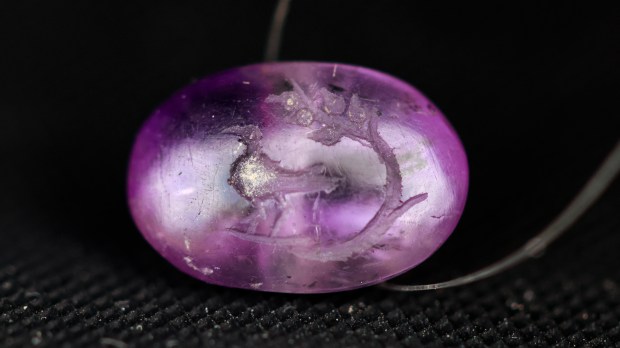The Israel Antiquities Authority announced that archaeologists have discovered, in the very foundations of the Western Wall in Jerusalem’s Old City, a 2000-year-old amethyst seal with an engraving that portrays the biblical “Balm of Gilead,” a plant used to obtain incense, perfume, and ointments often used for medicinal purposes.
As read in the Jewish News Syndicate, the finding is indeed exceptional. The oval stone, which is about 10 millimeters long, five millimeters wide, and seven millimeters thick, features a branch bearing five pieces of fruit. After examining the engraving, the archaeologists said they believe that it depicts the persimmon perfume plant that is referred to in several different passages of the Hebrew Bible as “the Balm of Gilead.”
Take, for example, Genesis 37:25. The passage presents Joseph’s brothers seeing a caravan going from Gilead to Egypt “with their camels bearing spicery, and balm, and myrrh.” In Genesis 43:11, we see Jacob giving “a little balm” to an unknown ruler when dispatching his embassy into Egypt. And, in the book of Jeremiah, we find the prophet asking whether there is balm in Gilead or not (Cf Jeremiah 8:22).
The leading archaeologist Eli Shukron, who conducted the excavation, told JNS that “this may be the first time that a seal has been discovered in the entire world with an engraving of the precious and famous plant, which until now we could only read about in historical descriptions.” Professor Shua Amorai-Stark, also part of the archaeological team and an expert in engraved gems, explained that “toward the end of the Second Temple period, the use of stone stamps expanded and became more common, but most of the stamps discovered so far with plant engravings were of vines, dates, and olives, but on this stone seal, we immediately noticed that the fruit that appears on it is unlike any of the fruits we have encountered to date.”
Shukron also told the JNS that “the balsam plant is a positive symbol because, beyond the fact that it was used to produce perfumes and medicines, the ancient persimmon — which, by the way, is not at all similar to today’s persimmon — was attributed magical and ceremonial properties and is one of the ingredients used for making the Temple incense during the Second Temple period, which is when this seal was made.”

